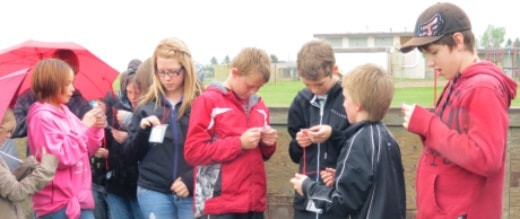Some Rimbey Elementary School students got to experience last week what it would be like to endure the harsh living conditions in refugee camps throughout the world.
The students stood in the pouring rain waiting patiently for admission to the simulated camp set up by Avery Acheson, rural awareness co-ordinator with the Central Alberta Refugee Effort in Red Deer, and school librarian Jamie Coston.
The purpose of the exercise was to provide education and awareness to the students about the plight of refugees in such camps throughout the world.
Acheson, who played the role of a United Nations personnel, spoke sternly to the children waiting to enter the camp.
“You can take it or leave it,” he said. “If you chose to leave you are no longer safe. The soldiers out there might kill you.”
As the children stood listening to the stringent rules, Acheson explained, in a voice that commanded respect and obedience, the importance of keeping their identification tags with them at all times.
The tags listed their name, age and country of origin.
Once the children were issued identification tags, he took them to a small shelter where he explained they would have one cooking pot, and an open fire with which to cook. One blanket to be shared between four and six people was also issued.
A shovel with which to dig a latrine 15 metres away from any living area is also a basic supply, he said.
Every two weeks food supplies consisting of wheat flour, sugar, beans and cornmeal will be handed out, Acheson said.
Patience while standing in the food line is of utmost importance, he added, noting it may take up to 14 hours to get the food, but any pushing and shoving is strictly prohibited. Anyone caught indulging in this type of activity would be taken out of the lineup and would have to wait another two weeks for their food rations.
Water is in short supply and a refugee is allowed to receive only three to five litres daily.
“Guard food and water rations carefully,” he said.
Even in a refugee camp, where living conditions are dismal and food and water at a premium, limited education is offered. Teachers are refugees, themselves.
“Education is your best way out,” said Acheson.
While the students did their best to absorb the horrific facts about living in a refugee camp, Acheson showed them a soccer ball made out of garbage bags that could be used to provide some recreational fun.
“You have to be creative and come up with your own ideas,” he said.
Landmines, designed to seriously maim any individual who had the misfortune to step on one, had been mostly removed from the camp, he said.
“We tried to get rid of them in the camp, but there may be some here still,” he said. “Keep a sharp eye out, remember they’re designed to hurt people.”
There is a hospital, he added, noting the waiting list to see a doctor is long as there are 100,000 people in the camp and the hospital is small.
Cholera and malaria are common illnesses at refugee camps, he said, adding that if they ran short of water they welcome to go to the river about 10 kilometres away, but the water could be contaminated and the trek there and back would not be safe.
Despite the fact the rain had almost ceased by the time Acheson had delivered his message, at least some students appeared somewhat sobered by Acheson’s message.
“You can survive, but it wouldn’t be very good,” said Cierra Lozo, a 12-year-old Grade 6 student.
Students were given fate cards at the end of the exercise. Lozo was pleased her fate card told her she was one of the refugees who would leave the camp and later move to Red Deer. Although she would endure racism and subsequent depression, she was pleased she would not remain at the refugee camp and die there.
Shijiunn Du, also a 12-year-old Grade 6 student, thought the presentation was “cool.”
“It really makes me realize how much I appreciate living here with lots of good food and a warm, safe house. I’m glad I live here.”
Du’s fate card said she would move to Australia and later return to her country of origin.
There are more than 40 million refugees in the world, said Acheson, adding exercises such as the one held in Rimbey helps create public awareness and promote tolerance and understanding.
By Treena Mielke
